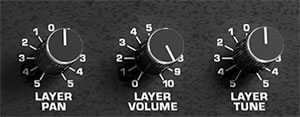Following are some extra per-layer Program section controls that don't easily fall into a category. These next few are smack in the middle of the panel:

Glide switch and Glide Rate knob- The Glide Rate knob causes notes to slide smoothly from one pitch to the next. Higher settings result in a slower change of pitch. The Glide switch enables or disables glide; it's handy if you'd like to quickly enable or disable glide for one of the layers only.
Number of Voices- Sets the maximum number of notes that can be played polyphonically from 2 to 16 max. Note that this is per layer, so the max polyphony for the entire layer is really 32 notes. (We should've called it the "Prophet-32")
Unison/Unison Detune- Unison stacks multiple voices according to the current No. of Voices setting. The Unison switch is used in conjunction with the Unison Detune knob which spreads out the tuning of the oscillators for fat sounds. The keyboard will only play monophonically (i.e., one note at a time) when the Unison switch is engaged.
The poly modes are last-note priority. When the max number of notes is reached, the oldest note will be stolen. With any modern computer, you should be able to leave these at 16, but we've provided lower settings to save processor cycles in case you're still holding on to that Pentium II machine (let us know how things are going on other planets on Stargate SG-1).
Mono Retrigger- On the original instrument, when sett to mono mode (aka Unison), envelope retriggering was legato only; that is, the envelopes would only retrigger once all keys were released. We've added a Mono Retrigger button which allows the envelopes to retrigger any time a new note is played, regardless of currently held notes; this is useful for "faster," punchier leads and bass lines.
If you're not clear on this mono retriggering business, a good analogy is playing individual notes on a guitar: legato is similar to picking one time and moving your finger up and down the string; retrigger is like picking every single note individually.
The following per-layer controls are found in the upper-right corner:

Layer Pan- Sets pre-effects left/right panning for each layer.
Note that this can be potentially confusing when effects are applied. The Distortion and Phaser effects are mono, so their stereo position moves with the Layer Pan control as you'd expect. However, because the Chorus/Flanger, Delay, and Reverb effects are stereo effects intended to stereoize mono signals, only the dry signal moves with the Layer Pan control; the Chorus/Flanger, Delay, and Reverb stereo images remain (relatively) the same. This may seem counterintuitive, but you generally don't want a giant, lush stereo reverb getting squished down to tiny one-channel mono.
Layer Volume- Sets overall volume for each layer. This is useful setting for balancing the overall levels of layers.
Layer Tune- Allows detuning of each layer by up to a semitone up or down.